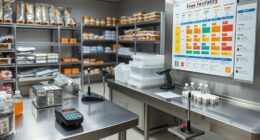Executive Summary
Business concept: This plan outlines “Global Fusion Tastes,” a new food truck serving international street‑food dishes. The truck will offer a rotating menu of globally inspired tacos, bowls and street snacks made from fresh, locally sourced ingredients. The goal is to provide busy urban customers with high‑quality, adventurous meals at reasonable prices while building a loyal following through consistent branding and excellent service.
Unique value: The menu fuses flavors from Latin America, Asia and the Mediterranean—combining techniques like kimchi fermentation with familiar formats such as tacos and rice bowls. Customers can expect bold flavors and seasonal specials, and the truck’s bright, artistic design and social‑media presence will ensure visibility. Sustainable practices—including compostable packaging and sourcing from local producers—appeal to environmentally conscious diners.
Financial overview: Start‑up costs are estimated at $100,000–$120,000, including a used 18‑foot truck ($60,000), kitchen equipment ($20,000), permits and licenses ($1,500–$3,000), POS system ($3,000), initial inventory and supplies ($3,000–$5,000), and branding and marketing ($10,000). This range aligns with industry estimates; an average food truck start‑up cost is approximately $89,477upmenu.com, and total launch costs for 2025 generally fall between $100,000 and $250,000cloudwaitress.com. Monthly operating costs are projected at $8,000, within the typical $5,000–$10,000 rangecloudwaitress.com. Conservative revenue projections assume 60 orders per day at an average ticket of $12 ($21,600/month). At 65% cost of goods sold and operating expenses, the truck should achieve a profit margin around 10%–12% after the first year.
Objectives:
- Launch by spring 2026 with all permits, licenses and equipment secured.
- Achieve break‑even sales volume (approximately 1,800 orders per month) by month six, consistent with industry examplesupmenu.com.
- Build an online community of at least 5,000 followers across Instagram and TikTok during the first year.
- Expand catering offerings and attend at least two major regional festivals in year two.
Company Description
Global Fusion Tastes will operate from a fully equipped 18‑foot truck built on a step‑van chassis. The company’s mission is to provide high‑quality, globally inspired street food using local ingredients and sustainable practices. The truck will prepare food on board, using a commissary kitchen for prep and storage as required. Customers will find the truck in busy business districts for lunch and at events or breweries on evenings and weekends.
Business structure: The business will be registered as a limited liability company (LLC), with ownership split equally between two partners. One partner will manage culinary operations, leveraging experience in restaurant kitchens, while the other will handle marketing, finances and community outreach.
Competitive advantage: The truck will differentiate itself through its eclectic menu, emphasis on sustainability, and strong branding. With only two to three employees, labor costs remain manageable. Many trucks in the area focus solely on American staples; by offering global fusion, the business taps into consumers’ interest in diverse street foods and premium ingredients. Sustainability—using compostable packaging and locally sourced produce—will attract eco‑conscious customers.
Market Analysis
Industry trends: The U.S. food truck market is valued at around $1.09–$4.36 billion in 2025, with projected annual growth of 5–6.4%cloudwaitress.com. Food trucks generate $250,000–$500,000 in annual revenue on averagecloudwaitress.com, and the top quartile exceed $492,000cloudwaitress.com. Monthly operating costs range from $5,000 to $10,000cloudwaitress.com, while ingredients and supplies account for about 25–35% of revenuecloudwaitress.com. Permits and licenses typically cost $1,000–$3,000cloudwaitress.com. Overall profitability depends on location, menu type, staffing and adoption of technology.
Target market:
- Primary audience: Young professionals and urban residents aged 25–45 who appreciate adventurous cuisine and value sustainability. These customers seek convenient, high‑quality meals during lunch breaks and after work.
- Secondary audience: Event attendees and festival‑goers seeking unique dining experiences.
- Geographic focus: Business districts, office parks and mixed‑use urban neighborhoods in the chosen city. Locations near breweries and outdoor events will be targeted on evenings and weekends. A geofencing strategy will align with customer movement.
Competitive landscape: The local market hosts about five established food trucks and several fast‑casual restaurants. Competitors mainly serve Mexican, barbeque or comfort‑food menus with limited international offerings. A few have strong social‑media followings but focus on single cuisines. By offering a fusion concept and rotating specials, Global Fusion Tastes will fill a niche. Price points will align with fast‑casual restaurants ($10–$14 per entrée) but offer more variety and sustainable packaging. Barriers to entry include licensing, parking permits and equipment costs; established trucks enjoy brand recognition, but new concepts often attract initial buzz.
Menu and Product Line
The menu will feature a core selection of globally inspired tacos and bowls, along with seasonal rotating specials. Core items include:
- Korean BBQ Taco: Short rib marinated in gochujang, topped with pickled daikon and cilantro on a corn tortilla.
- Mediterranean Falafel Bowl: Crispy falafel over turmeric rice with cucumber salad, tahini sauce and pickled turnips.
- Caribbean Jerk Chicken Bowl: Spicy jerk chicken over coconut rice with mango salsa and plantain chips.
- Asian Fusion Fries: Crispy fries topped with kimchi, sriracha mayo and scallions.
- Seasonal Special: A rotating dish featuring local ingredients (e.g., spring asparagus fritters or autumn roasted pumpkin tacos).
Products will be prepared on the truck using fresh ingredients purchased from local markets and suppliers. Seasonal menu changes will encourage repeat visits and allow for creative promotions. The truck will also sell house‑made sauces and pickles in retail jars as an additional revenue stream.
Marketing and Sales Strategy
- Branding and design: A vibrant truck wrap featuring global motifs and a consistent color palette will create visual impact. A simple, memorable logo will be used across signage, menus and merchandise.
- Digital presence: A mobile‑friendly website will display the menu, schedule and ordering options. Active Instagram and TikTok accounts will showcase food photography, behind‑the‑scenes content and location updates. Posting schedule will follow best practices (daily Instagram Stories and 3–4 weekly feed posts). Encouraging user‑generated content with hashtags and reposts will amplify reach.
- Location strategy: High‑traffic lunch spots (office parks, campuses) will be targeted Monday through Friday. Evenings and weekends will focus on breweries, farmers’ markets, and special events. Use of location‑based social ads and partnerships with breweries will attract customers. Participation in at least two major festivals and occasional pop‑ups will build buzz.
- Loyalty and promotions: A digital loyalty program (punch‑card style) will reward repeat customers (e.g., buy nine tacos, get one free). Promotions like “Taco Tuesday” or “New Menu Friday” will introduce seasonal items. Launch promotions will include free samples and cross‑promotion with local businesses.
- Partnerships: Collaboration with local breweries for pairing events, as well as cross‑promotions with nearby gyms or coworking spaces. Partnerships with delivery platforms will expand reach, though the focus remains on direct sales to avoid commission fees.
Operations Plan
Equipment and build‑out: A used 18‑foot food truck will be purchased for around $60,000. Additional build‑out costs include kitchen modifications ($10,000), kitchen equipment (grill, fryer, refrigerator, prep table – $20,000) and smallwares ($2,000)upmenu.com. The truck will feature a generator for power, propane connections, a hood ventilation system and a three‑compartment sink to meet health codes. A commissary kitchen lease ($800/month) provides additional storage and prep space.
Permits and licenses: Estimated at $1,500–$3,000 for business license, health permits, sales tax permit, mobile vendor permit and fire inspectionscloudwaitress.com. These will be renewed annually with the help of a licensing specialist.
Staffing: Initially, the business will employ two owners (chef and operations/marketing) and one part‑time employee for busy shifts. Wages will average $20/hour, and payroll taxes and insurance will be budgeted accordingly. Hiring additional staff will occur as demand grows.
Operating hours: Monday–Friday 11 a.m.–2 p.m. (lunch) and Friday–Saturday 5 p.m.–9 p.m. (evenings), plus special events. Scheduling flexibility allows for private catering jobs. The truck’s location schedule will be updated daily on social media and the website.
Suppliers: Key ingredient suppliers include local produce wholesalers, a regional meat supplier and a bakery for tortillas and buns. Supplies such as compostable packaging and cleaning products will be purchased from a restaurant supply distributor. Negotiations will seek bulk discounts and sustainable product options.
Financial Plan
Start‑up costs (one‑time):
| Item | Estimated cost |
|---|---|
| Used food truck | $60,000 |
| Renovation and styling | $10,000 |
| Major kitchen equipment | $20,000 |
| Smallwares and utensils | $2,000 |
| Point‑of‑sale system | $3,000 |
| Initial inventory (ingredients and disposables) | $4,000 |
| Permits and licenses | $2,000 |
| Insurance (first year) | $3,000 |
| Branding, website and marketing | $10,000 |
| Miscellaneous (legal, accounting, contingency) | $6,000 |
| Total | $120,000 |
These estimates align with industry ranges ($100,000–$250,000 in 2025cloudwaitress.com) and sample plans ($145,750 total investmentupmenu.com). If the truck is leased instead of purchased, initial costs would drop but monthly payments would rise.
Operating expenses (monthly):
| Expense | Estimated monthly cost |
|---|---|
| Food and supplies (25–35% of revenue) | $3,600 (assuming 30% of $12/order × 60 orders/day) |
| Payroll (owners’ draw + one part‑time staff) | $4,000 |
| Commissary kitchen rent & utilities | $800 |
| Fuel and transportation | $700 |
| Insurance | $200 |
| POS and software fees | $200 |
| Maintenance & repairs | $500 |
| Marketing & promotions | $700 |
| Licenses & permits amortized | $100 |
| Total monthly expenses | $10,800 |
These costs fit within typical operating ranges: ingredients and supplies $1,000–$3,000 monthlycloudwaitress.com, fuel $500–$1,000cloudwaitress.com, cleaning and paper goods $200–$400cloudwaitress.com, and total monthly expenses $5,000–$10,000cloudwaitress.com.
Revenue projections:
| Month | Orders per day | Average ticket | Monthly sales | Variable costs | Fixed costs | Profit/Loss |
|---|---|---|---|---|---|---|
| 1 | 30 | $12 | $10,800 | $3,240 | $8,200 | –$640 |
| 2 | 45 | $12 | $16,200 | $4,860 | $8,200 | $3,140 |
| 3 | 60 | $12 | $21,600 | $6,480 | $8,200 | $6,920 |
| 4 | 75 | $12 | $27,000 | $8,100 | $8,200 | $10,700 |
| 5+ | 90 | $12 | $32,400 | $9,720 | $8,200 | $14,480 |
At 60 orders per day (1,800 orders/month), the business reaches break‑even in month three, consistent with the example plan where profitability begins after month fourupmenu.com. By month six, profits exceed $10,000 per month; achieving 90 orders per day yields an annual revenue of about $388,800—within the industry’s $250K–$500K rangecloudwaitress.com.
Break‑even analysis:
Fixed costs ($8,200) divided by contribution margin per order (sale price minus variable cost; $12 – $6 = $6) yields a break‑even volume of approximately 1,367 orders per month (about 45 orders/day). This is in line with sample calculations that set the break‑even point at 1,800 orders per monthupmenu.com.
Funding Request and Use of Funds
To cover start‑up costs of $120,000 and initial operating capital, the owners plan to invest $30,000 of personal savings and seek a $90,000 small business loan. The loan will finance the truck purchase, equipment, permits and marketing. The loan will be structured over five years at a projected interest rate of 8%. Monthly debt service (~$1,830) has been included in fixed costs. Additional funding may be sought from a community investment program or private investors if expansion to a second truck occurs after year two.
Milestones and Growth Plan
- Pre‑launch (Months 1–3): Finalize concept, secure financing, purchase and retrofit truck, obtain permits and licenses, develop menu, build brand identity and website, and test recipes.
- Launch (Month 4): Soft opening at a local brewery or event; gather feedback and fine‑tune menu; implement marketing campaigns; attend two events per month.
- Early growth (Months 5–12): Expand daily service to 3–4 core locations; launch loyalty program; achieve break‑even and profitability; build social‑media following; begin catering and private events.
- Year 2: Evaluate performance; consider adding a second truck or expanding hours; explore pop‑up collaborations or farm‑to‑truck dinners; increase profits to 15%+ by optimizing menu and costs.
Conclusion
A comprehensive business plan is essential for transforming the dream of a food truck into a sustainable venture. By clearly defining the concept, analyzing the market, planning operations, and setting realistic financial projections, prospective owners can attract investors, manage cash flow and navigate licensing requirements. With careful budgeting and a focus on unique offerings, Global Fusion Tastes is well positioned to thrive in a growing industry where average annual revenues range from $250,000 to $500,000 and profitability depends on disciplined cost controlcloudwaitress.com. Continual adaptation, strong branding and community engagement will ensure long‑term success.









